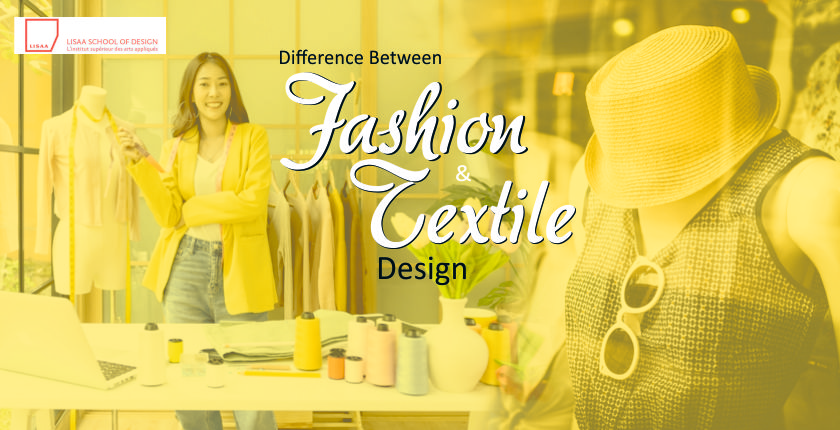Blog
Difference Between Fashion & Textile Design
- December 17, 2020
- Posted by: lisaadelhi
- Category: Fashion Design Blog

The world of fashion feels dreamy to the common man. From dazzling models, glamorous fashion shows, jaw-dropping clothes to talented designers – this world feels almost unreal. Plus, you cannot deny the amount of money and fame people in this industry enjoy!
All this might get you interested in building a career in fashion. While fashion designing and modeling are the first two career paths that pop up in your head, that’s not all. In this post, we will talk about two very interesting career choices – fashion designing and textile designing.
Fashion and textile design are two creative fields that often get lumped together. n this blog post, we’ll explore the unique aspects of each lot and provide insights into what sets them apart. So whether you’re a budding designer or just curious to learn more about fashion and textile design, read on to discover everything you need to know!
What is Fashion Designing?
Fashion designing can be considered as the art of creating clothes and accessories. It deals with a wide range of colors, patterns, fabrics, textures, and trends. While adding beauty to a piece of cloth or accessory, a new trend can be born. Fashion designing can also be aimed to create a particular style of products. Furthermore, clothes or accessories might be crafted to match someone’s lifestyle.
The field of textile design is broad and constantly evolving. New technologies are being continuously developed, giving textile designers many opportunities to be creative. For example, recent advances in digital printing have made it possible to print complex patterns and designs onto fabric. .
The two major categories of fashion designing are –
- Haute couture
This is a French term meaning high fashion. This line of clothing deals with creating exclusive custom-fitted clothes and accessories. This is where the world-famous brands and designers are involved mostly.
But any fashion designing house cannot call itself an haute couture house. For that, the house or designers need to be a part of the Syndical Chamber of Haute Couture, Paris. And not only that, the fashion house must present their collections two times a year. Each collection must have 35 different outfits.
- Ready to wear
As the name suggests, this line of clothing deals with clothes for everyday use. They are not custom made, are available in standard sizes, and are designed for everybody. Thus, these clothes are designed for mass production.
What is Textile Designing?
Textile designing is the art of creating products such as designs, printed fabrics, patterned fabrics, dyes, embroidery, and yarns. This field is vast and is not just limited to fashion designing. Textile designing covers products such as bulletproof vests, jackets, helmets, and wall coverings in cinema halls.
This field includes all the processes starting from collecting raw materials to launching the finished goods.
Fashion design and textiles go hand in hand, as the former can only exist with dynamic fabrics that capture the designer’s vision. And textile designing is where all the magic happens! It involves creating unique patterns, textures, and prints that bring life to a piece of cloth.
A textile designer works closely with fashion designers to understand their concepts and transform them into tangible fabrics that make jaws drop on the runway.
They experiment with materials like silk, cotton, wool, and rayon to create innovative designs using cutting-edge techniques such as digital printing or weaving machines. Whether sketching out ideas or manipulating structures on a computer screen, textile designers are in charge of every step of the creation process until they see their visions come alive.
In short: Textile designing is where art meets science; it’s an exciting field for those who love playing with colors and textures while being at the forefront of fashion innovation!
Difference between dyeing and printing
Do you know the difference between dyeing and printing? Well, let me tell you! Dyeing involves immersing fabric in a solution of colored substances to create a lasting color change.
It’s like giving your hair a new look with permanent hair dye. On the other hand, printing is the process of transferring a design or pattern onto the fabric using ink or pigment.
Think about it like getting a temporary tattoo on your skin that can be easily washed off later. While both processes involve adding color to fabric, they differ in permanence and application method. So now that you know the difference between dyeing and printing, which one will you choose for your next DIY project?
Similarities and Differences Between Fashion and Textile Design
There are a few key similarities and difference between textile and fashion designing. For starters, both fashion and textile design involves the creation of clothing and other garments.
However, textile design generally focuses on the fabric itself, while fashion design focuses on the garment’s silhouette, style, and overall look. Textile designers often create prototypes and samples of their materials, which are then sent to fashion designers to be made into garments.
Another critical difference between fashion and textile design is that textile design is typically more concerned with function over form.
This means that textile designers often must consider how a fabric will hold up under wear and tear or react to different weather conditions. On the other hand, fashion designers tend to be more concerned with aesthetics and ensuring that their garments look good on the runway or in magazines.
Despite these differences, fashion and textile design also have some fundamental similarities. Additionally, both fields require a solid technical background to be successful.
- The main difference between the two fields is that fashion designers focus on creating clothing and accessories, while textile designers focus on creating fabrics and other textiles.
- If you’re interested in working in the fashion industry, you’ll need to be aware of the latest trends and create stylish clothing that people will want to wear. On the other hand, if you’re more interested in designing functional textiles, you’ll need to understand different materials and how they can be used in various applications.
- Fashion designers typically need a strong sense of aesthetics, while textile designers need strong technical skills.
- There are many different specializations within both fashion and textile design, so you’ll need to decide which area you’re most interested in before making your final decision.
Take some time to research both fields and talk to professionals in each area before making your decision.
Topics Covered in Fashion Designing Course and Textile Designing Course
The various subjects covered in Fashion designing and Textile designing are –
| Fashion Designing Syllabus | Textile Designing Syllabus |
| Introduction to Fashion Designing | Introduction to Textile designing |
| History of Fashion | Elements of design |
| Fashion theory | Print design |
| Fashion technology | Pattern making |
| Apparel development | Basic designing and Design Art |
| Fashion illustration and sketching | Structural Fabric Design |
| Fabric Dyeing and Printing | Computer-Aided Textile Design |
| Fashion management | Pattern making |
| Fabric Dyeing and Printing | Garment production management |
| Fashion trends and forecasting | Basics of apparel merchandising |
Eligibility & Skills for being a Fashion Designer
You need to have the following skills to become a fashion designer –
- Creativity and artistic thinking
- Attention to detail
- He/she must be good at drawing
- Good communication skills
- He/she must have originality and innovativeness
The basic eligibility to pursue fashion designing is completing class 12 from any stream from a recognized board. For obtaining a Bachelor’s Degree in Fashion Designing, students have to undergo an entrance exam to enter a reputed institute. Later on, students can also go for a post-graduate degree in fashion designing.
Eligibility & Skills for being a Textile designer
Skills required to be a textile designer –
- Creativity
- Detail-oriented
- Must have a good eye for fabrics, patterns, colors, and textures
- A good understanding of the various textile designing processes and techniques
- Awareness of the trends in the textile industry
- Team-working and communication skills
The basic eligibility to pursue textile designing is completing 10+2 from a recognized board. You might have to sit for an entrance exam to enroll in a UG course in textile designing. A minimum of 50 to 60 % marks is required in 10+2.
Role of Fashion Designer
The roles and responsibilities of a fashion designer are –
- Conducting market research and identify trends, fabrics, designs, and techniques
- Oversee the entire design process starting from conceptualization to product finalization
- Create mood boards, samples, and presentations for clients
- Communicate with team members to modify themes to make new ones and create concepts
- Contact the technical designer to ensure that the development package is accurate
- Analyze the style and fir for the products
- Visit various fashion stores and events, to see and buy fabrics, trims, and embellishments
Role of Textile Designer
The roles and responsibilities of a textile designer are –
- Creating samples, sketches, and designs for clients and customers
- Understanding the client’s requirements and working on designs accordingly
- Assessing the quality standards of the finished designs and products
- Using software and CAD (Computer-Aided Design) to develop a range of designs
- Being aware of the industry trends and techniques of textile designing
- Visiting trade shows and representing the company with a stand
- Communicating with business partners and developing the network
Career Options for a Fashion Designer
A fashion designer can be employed by companies in the following sectors –
- MNCs
- Garment stores
- Corporate businesses
- Media firms
- Textile houses
- Retail companies
- Boutiques
- Universities and institutes as a fashion designing faculty
Top companies that hire fashion designers are –
- Marks & Spencer
- Pantaloons
- Raymonds
- Spykar
- Lee
- Levis
- Lee Cooper
- Ritu Kumar
The average salary of a fashion designer in India is ₹3,92,053 LPA. Along with experience and skills, a fashion designer can earn up to 12 LPA.
Qualifications Needed for Each Field
There are a few essential qualifications that are needed for each field. For fashion design, you must have a good eye for detail, visualize concepts, and have strong sewing skills. For textile design, you will need an understanding of fabric properties, weaving, and printing techniques.
Career options for a Textile Designer
Textile designers are mostly hired in the following sectors –
- Garment factories and stores
- Fashion houses
- Television and Media industry
- MNCs
- Knit-Wear Designers
- Fashion showrooms
Top companies that hire fashion designers are –
- Silver Spark Apparel Ltd.
- Raymonds
- Reid and Taylor
- Bata
- Swarovski
- Pantaloons
- Adidas
The average salary of a fashion designer in India is ₹6,40,000 LPA. As the candidate gains new skills and experience, this salary package can go up to ₹ 12 LPA.
Conclusion
The fashion industry is brimming with opportunities. Thus, a career in fashion designing or textile designing will set you for a successful life. And not only that, once you gain sufficient experience, you can start your brand or freelance for some company.
Fashion and textile design are two very distinct yet interconnected fields. While fashion focuses on clothing aesthetics, textile design emphasizes ensuring comfortable clothes. You can decide which suits your interests best by learning more about both disciplines and their respective roles.
Leave a Reply Cancel reply
You must be logged in to post a comment.

